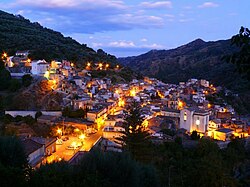Mandanici
|
Mandanici Mannanici |
|
|---|---|
| Comune | |
| Comune di Mandanici | |

Mandanici by night
|
|
 Map of the comune of Mandanici within the province of Messina |
|
| Location of Mandanici in Italy | |
| Coordinates: 38°0′N 15°19′E / 38.000°N 15.317°ECoordinates: 38°0′N 15°19′E / 38.000°N 15.317°E | |
| Country | Italy |
| Region | Sicily |
| Province / Metropolitan city | Province of Messina (ME) |
| Government | |
| • Mayor | Armando Carpo, since 10/06/2009 |
| Area | |
| • Total | 11.7 km2 (4.5 sq mi) |
| Elevation | 417 m (1,368 ft) |
| Population (Dec. 2004) | |
| • Total | 695 |
| • Density | 59/km2 (150/sq mi) |
| Demonym(s) | Mandanicesi |
| Time zone | CET (UTC+1) |
| • Summer (DST) | CEST (UTC+2) |
| Postal code | 98020 |
| Dialing code | 0942 |
| Patron saint | Santa Domenica |
| Saint day | Second Sunday of August |
| http://www.comunedimandanici.it | |
Mandanici (Sicilian: Mannanici) is a comune (municipality) in the Province of Messina in the Italian region Sicily, located about 170 kilometres (110 mi) east of Palermo and about 30 kilometres (19 mi) southwest of Messina. As of 31 December 2004, it had a population of 695 and an area of 11.7 square kilometres (4.5 sq mi).
Mandanici borders the municipalities of Fiumedinisi, Nizza di Sicilia, Pagliara, Roccalumera, and Santa Lucia del Mela.
Mandanici, a small centre in the Province of Messina, was founded in a broad valley on the slopes of Pizzo Luci at the foot of the Peloritani. Its origin is uncertain, but it is claimed that it was founded by Greek colonists during the Chalkidean migration. More secure evidence exists from the period of Norman rule, as it was recorded in the royal historian Don Rocco Pirri's Sicilia Sacra. Even today, Mandanici's historical cultural importance is attested by the duomo, with its frescoes and amazing wooden roof and terracotta columns from local sources; by the remains of the abbey of San Basilio, which was erected at the impetus of Roger II (1100) to be a centre of international study, gatherings and religion; and by the works of art like the canvas and plaster crucifix from 1600 in the church of SS. Trinità la Madonna del Cesto, the paintings of Subba, and the Norman churches.
Another monument of historical value is the church of SS. Salvatore from the seventeenth century, which has been restored and designated a Museo Etnocintropologico. The local library is full of books on medicine, history, and theology from the sixteenth century.
...
Wikipedia

